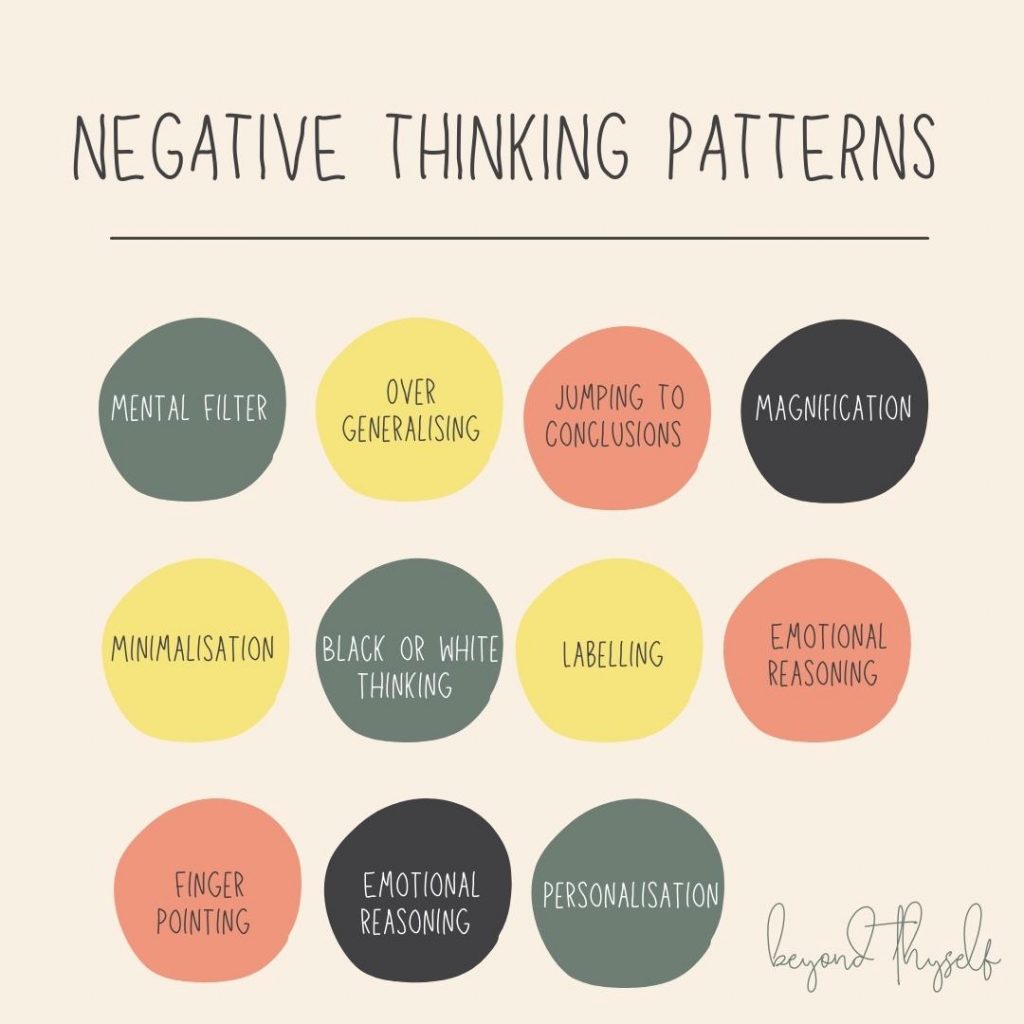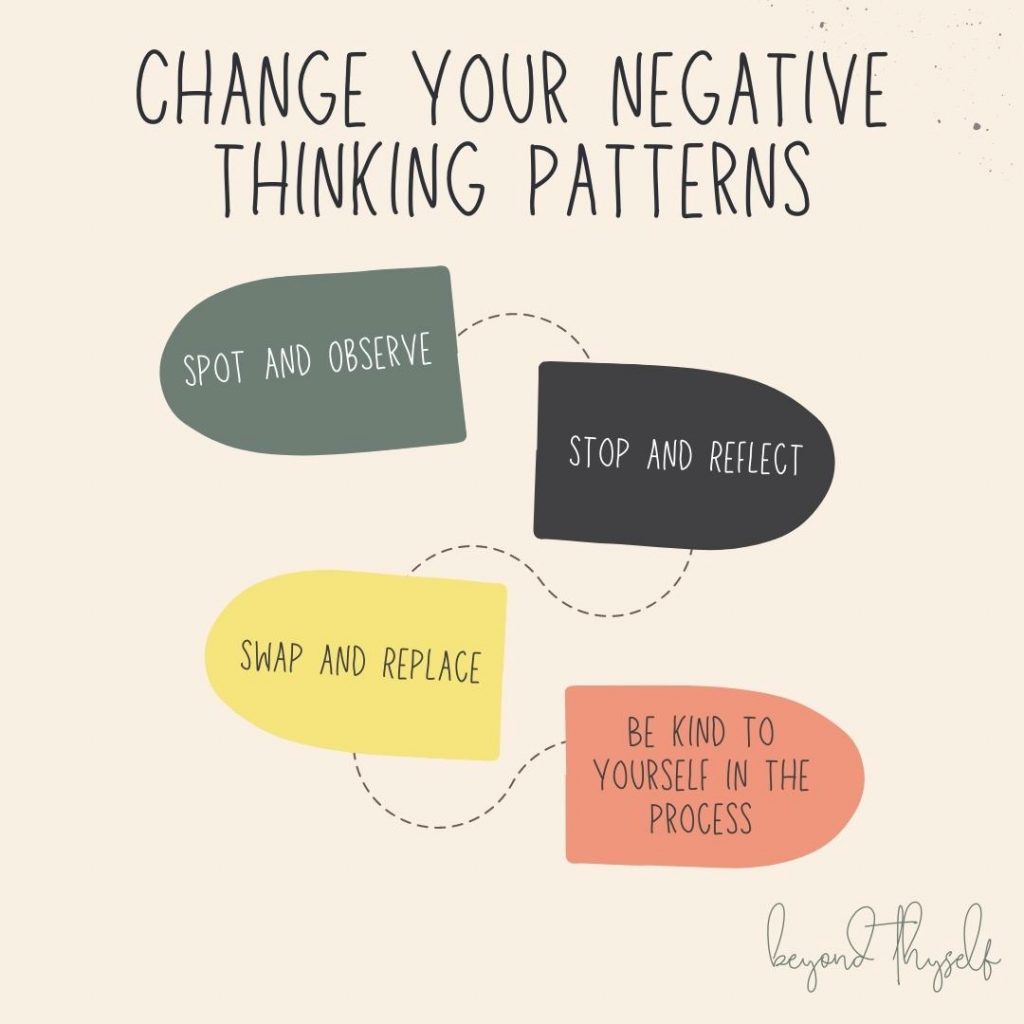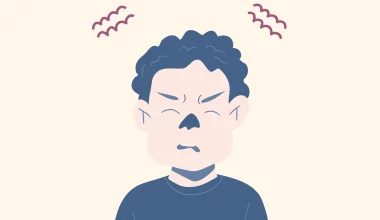Do you often find yourself imagining the worst possible outcomes in your life?
Do you tend to think negatively about yourself, your life, and the people around you?
Have you ever been in a situation that made you feel pessimistic, fearful, and anxious, only to discover that it turned out to be one of the most incredible experiences of your life?
You’re not alone! We all can make our thoughts more real than anything else.

Did you know that our negative thoughts can trigger unpleasant emotions such as anxiety and despair? These thoughts are called “Cognitive Distortions” and can significantly impact our mental well-being.
However, there are ways to identify and challenge these thoughts so you can become more aware of their impact and consciously choose to change them.
So, let’s take a moment to breathe deeply and begin our journey toward better understanding these irrational thinking patterns, ourselves, and the world around us!
What Are Cognitive Distortions?
Cognitive distortions refer to inaccurate ways of thinking that we adopt about ourselves and the world we live in. For instance, when we think, “If I can’t do something perfectly, then there’s no point in doing it,” or “I feel stupid, so I must be stupid,” we are engaging in irrational thoughts and beliefs that we unconsciously reinforce over time.
These distortions can have a negative impact on our self-image, leading to issues like low self-esteem, depression, and anxiety. Ultimately, these distortions cause us to perceive reality in a hostile and unhelpful way.

Have you ever found yourself wondering where cognitive distortions come from? Those sneaky little thoughts that make you feel like you’re not good enough or that others are out to get you?
Let’s uncover the most common cognitive distortions that can wreak havoc on your life. But don’t worry—we’ll also explore how you can recognize and overcome them to start living a more positive and fulfilling life!
Where Do Cognitive Distortions Originate?
In his work on cognitive behavioral therapy, psychiatrist Aaron Beck found that people develop cognitive distortions to cope with difficult life situations. The more a person has negative thoughts or beliefs about the severity of their situation, the more likely cognitive distortions will form and lead to harmful behaviors toward oneself.
The Most Common Cognitive Distortions
Awareness of cognitive distortions that may cloud your thinking is essential. Take the time to read through these distortions and pay attention to the ones that frequently arise. Doing so, you can better understand your thought patterns and approach each situation with greater clarity and perspective. Below are some of the most common ones.

Mental Filter:
A mental filter occurs when one focuses only on the negative aspects of a situation and ignores all the positive ones.
For instance, in a relationship, your partner may express their love for you and enjoy spending time with you, but they might also mention that they need alone time to recharge. Focusing on the fact that your partner needs alone time could cause you to feel anxious and insecure in your relationship. This mental filter can make you overlook the positive aspects of your relationship and only focus on the negative.
Overgeneralizing:
Overgeneralizing is when you make an unreasonable false assumption and reach one broad conclusion about one event.
For instance, if someone eats a type of sushi they don’t like, they might assume that all sushi is disgusting and refuse to try it again. This thinking needs to be more accurate, as one might enjoy many types of sushi with different flavors and ingredients. It is important to recognize when we overgeneralize and challenge those thoughts with evidence that contradicts them.
Jumping to Conclusions:
Jumping to conclusions is when you make a negative interpretation or prediction based on a false thought and feeling to support your findings. It can show up as “mind reading, “in which you assume the thoughts and intentions of others, or “fortune-telling,” in which you anticipate the worst and accept it as a fact.
Mind-reading example: You wake up and don’t find a sweet good morning text from your partner. You start feeling unloved by your partner and conclude that maybe he is angry with you and doesn’t love you anymore.
Fortune-telling example: You will take a national exam, but you already believe you will fail before even taking it.
Magnification (Catastrophizing):
Magnification is when you blow one small event out of proportion, imagining all sorts of disasters. Catastrophizing ordinary worries into life-threatening ones.
For instance, you are running late for work, and when you finally get there, your boss greets you with, “Oh, hi, you’re late today.” You apologize, but in your mind, you start to worry that you might lose your job. You begin thinking about the devastating consequences of losing your job – you wouldn’t be able to provide for your family, and you would lose your house and all your belongings. The fear of finding a new job starts to set in.
Minimization:
Minimalization is when you place little worth on yourself and play down your positive attributes. It’s when you devalue yourself and idolize others, leading to low self-esteem and confidence.
For instance, imagine you were asked to do the dishes. You did it in your own way, but then your friend comes in and tells you that you did it wrong and that it should be done differently. You start feeling like a worthless person who can’t do anything right at that moment.
Black or White Thinking:
Black-or-white thinking leads to intense emotions and behaviors. It sees all situations and people as good or bad, with no middle ground. This extreme way of thinking doesn’t give space to other shades of grey between black and white; you’re either perfect or a failure.
For instance, you’ve been trying to work out more regularly. You’ve been doing well, but then you missed one day. You start to feel disappointed in yourself for not being able to keep up with your consistent training schedule. You might even think you’ll never be fit enough to achieve your goals. This negative self-talk can be discouraging and even cause you to give up your fitness journey.
Labeling:
Labeling is assigning negative characteristics to yourself or others based on behavior in a particular situation or how others have judged that behavior. It’s important to realize that your behavior doesn’t define you as a person, and making mistakes and being imperfect is a natural part of being human.
For instance, when we see someone dressed up uniquely, we label them as weirdos instead of appreciating their sense of style.
Emotional Reasoning:
Emotional reasoning allows feelings to control your life and blind you from reality. Whatever you’re feeling is a fact.
For instance, you concluded that cats are scary and aggressive because of your fear of them.
Rigid Rule Keeping (Should or Shouldn’t):
Right and wrong thinking occurs when you keep a list of rules about how you and others should behave. Those who break the rules make you angry, and if you break them, you feel guilty. You box yourself in an inflexible, rigid, unrealistic world and expect everyone to follow your way.
For instance, if someone forgets to reply to an email, they may become very hard on themselves and believe they are terrible for making such a mistake. Their rigid rule-keeping can cause them stress and anxiety and prevent them from enjoying life to the fullest.
Finger Pointing
Finger-pointing is when you blame others instead of taking responsibility for your actions and life.
For instance, it’s easy to blame others if you’re unhappy or unsatisfied with your life. However, more is needed to improve your situation. Instead, focus on taking action and developing new habits that can help you improve your life and achieve your goals.
Personalization:
Personalization occurs when you believe that everything others say or do is a direct, personal reaction to you. You compare yourself to others and try to determine who is more intelligent, prosperous, better looking, etc. Moreover, you hold yourself responsible for external events or people out of your control.
For instance, your son missed several classes. Instead of assisting him in learning the reasons behind his fallout, you blame yourself for being a terrible parent.
How to Cope With Cognitive Distortions: The Three-Step Approach – Spot, Stop, Swap
Recognizing and changing cognitive distortions can be challenging and emotional. It requires mental work to reach a neutral state where the mind and body are in harmony, but it’s worth the effort.
It’s important to remember that thoughts and feelings are a natural part of the human experience, and it’s okay to have them. By acknowledging that thoughts are the brain’s language and feelings are the body’s language, you can create a path for change.
Remember that you’re not alone in this journey. Here are some practical steps that can help you change these thoughts:

Step 1: Spot and Observe
Our thoughts influence our emotions, and often, our bodies respond to these feelings in noticeable ways. If you are experiencing anxiety, agitation, frustration, moodiness, or fear in response to a certain situation, the first step is to be aware of these feelings and observe them. Take deep breaths as needed to help calm yourself.
Scan your body and notice where you hold tension. Observe the tightness of your hands, shoulders, and jaw, your body’s shakiness, and your heart’s racing. Through your deep breaths, connect to your body and try to bring back calmness to it lovingly.
You can use affirmations to help you through this step, such as:
I release all tension from my body
I relax my hands
I relax my jaw
I relax my scalp
I relax my face
I relax my shoulders
I relax my body
I inhale peace
I exhale fear, worry, and any negative feelings
I’m safe
All is well
Step 2: Stop and Reflect
Take a moment to be still and reflect on your feelings. Ask yourself these questions to gain a better understanding of why you’re feeling the way you do:
What emotions am I experiencing? Am I feeling moody, depressed, or anxious?
Is the cause of my feelings related to a person or situation, or is it something within myself?
Is there anything I can do to control or alleviate my emotions?
Are my thoughts based on reality, or am I creating scenarios?
What specific thoughts are causing me to feel this way?
Did I hear or see something that scared me or made me uncomfortable? Did I encounter someone who irritates me?
As you consider these questions, write down your answers. You can use a journal, memo app, or piece of paper. Whatever method works best for you.
After you’ve written down your answers, take a moment to review the common cognitive distortions mentioned earlier. Identify which destructive thinking patterns you may have unconsciously used to respond to the specific event in your life.
Remember, it’s okay to have only some of the answers. The most important thing is to be aware of your thoughts and feelings and to take the necessary steps to address them.
Step 3: Swap and Replace
After recognizing which cognitive distortion you experienced in that specific situation (you can refer to the examples mentioned above), it is essential to embrace that fact so that you start working on eliminating the unhelpful thinking patterns and replacing them with real ones.
To replace these negative thoughts, ask yourself some constructive questions, such as:
Do I want to continue feeling this way?
Do I want to respond negatively and unhelpfully?
Do I want to let these distorted beliefs control my life?
Do these unhelpful thinking patterns help or hurt me?
If you realize these thoughts are more harmful than helpful, it’s time to replace them with more realistic and positive ones consciously. Remember, change takes effort and time. You will need to repeatedly practice replacing these negative thoughts until they become a natural and unconscious habit.
Keep in mind that it’s essential to be patient with yourself. Your brain needs time to learn and change. By committing to this process, you can move beyond your limitations and achieve a more positive and fulfilling life.
The “Spot, Stop, Swap” process can be challenging and requires mental effort to break old negative thought patterns. It is perfectly normal for your body to react in the same way while you work on changing, as that is what you have developed in the past.
Reprogramming your mind and body requires practice, patience, and compassionate self-talk when faced with situations that may trigger a negative response. Remember to be kind to yourself throughout the process.
Take Action: Effective Strategies for Addressing Cognitive Distortions
While the three-step approach mentioned above is an effective way of tackling cognitive distortions, it’s important to incorporate additional strategies in your everyday life to reinforce your progress and help you in your journey of addressing negative patterns. Here are some practical ways that you can incorporate into your routine to achieve this goal:

- Cognitive Behavioral Therapy (CBT): This form of psychotherapy can effectively treat cognitive distortions. It focuses on challenging and changing unhelpful thinking patterns and behaviors, improving emotional regulation, and developing personal coping strategies to solve current problems.
- Mindfulness and Meditation: These practices help cultivate an awareness of the present moment, allowing you to recognize and understand your thoughts without immediately reacting to them. This can help you identify and manage cognitive distortions before they spiral out of control.
- Practice Self-Compassion: Being kind to yourself when you make mistakes or fail can help lighten the effects of cognitive distortions. Recognize that everyone makes mistakes and use them as opportunities for growth rather than reasons for self-blame or criticism.
- Regular Exercise: Physical activity can profoundly impact depression, anxiety, and more. It also relieves stress, improves memory, and boosts overall mood. Regular exercise can help your body better cope with stress and reduce the likelihood of falling into cognitive distortions.
- Surround Yourself with Positive Influences: The company you keep can significantly impact your thought patterns. Surround yourself with positive, supportive people who encourage and inspire you. This can help you develop a more positive mindset and reduce the prevalence of cognitive distortions.
Remember, overcoming cognitive distortions isn’t something that happens overnight. It’s a process that requires effort, patience, and resilience. However, by implementing these strategies, you’ll be well on your way to a healthier and happier mindset.
Don’t forget, it’s OK to ask for help! If you’re finding it difficult to manage your negative thoughts, don’t hesitate to seek professional help. Therapists, counselors, and other mental health professionals are trained to help you navigate these challenges and provide the support you need.
Understanding and addressing your cognitive distortions, you’ll be better equipped to manage your emotions, improve your relationships, and lead a more fulfilling life. Keep practicing and stay positive!
How to Apply the 3 Steps to Change Your Negative Thinking Patterns: A Real-Life Example
Let’s examine a familiar situation, a missed promotion at work, to illustrate how to apply these steps.
Situation: Imagine that you have been working hard to earn a promotion at your workplace. You put in extra hours, improve your skills, and receive positive feedback from your colleagues. However, when the promotion is announced, it goes to someone else. This news disappoints you, and negative thoughts start to fill your mind. You might even have thoughts like, “I am not good enough. I will never get promoted.”

Now, let’s apply the three steps to change this negative thinking pattern:
- Spot and Observe: The first step is to identify these negative thoughts. In this situation, you might recognize thoughts such as “I’m not good enough” or “I’ll never get promoted.” You also note the feelings of disappointment, rejection, and perhaps a physical reaction like a pit in your stomach or tightness in your chest.
- Stop and Reflect: Once you’ve spotted the distorted thoughts, stop and reflect on them. Are they based on reality? You might realize that not getting a promotion doesn’t necessarily mean you’re not good enough or’ll never get promoted. It could be due to factors beyond your control, like budget cuts or the other person having more experience.
- Swap and Replace: The final step is to replace these negative thoughts with more positive or neutral ones. Instead of thinking, “I’m not good enough,” you could think, “I did my best and have improved my skills significantly.” Instead of “I’ll never get promoted,” consider, “I didn’t get this promotion, but that doesn’t mean I won’t have other opportunities in the future.”
By following these three steps—Spot and Observe, Stop and Reflect, Swap and Replace—you can shift your negative thinking patterns into more positive ones, thus reducing the power of cognitive distortions over your mental well-being.
Becoming aware of these negative thinking patterns will help improve the quality of your life and relationships. Your decision is yours to make.
Remember, it’s a process, and change won’t happen overnight. Be patient with yourself and acknowledge each small victory in your journey toward a healthier mindset!
Peace and Words
Unboxed Human






